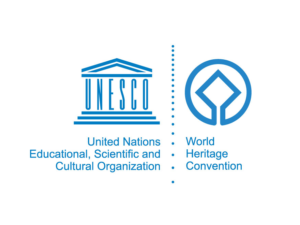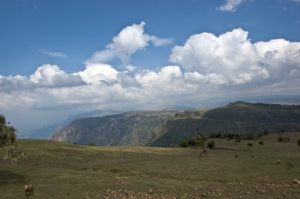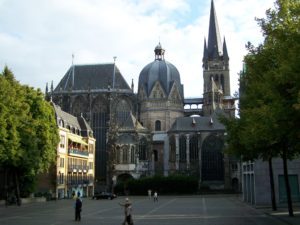UNESCO is one of those darned acronyms that we all have heard of, but perhaps can’t quite explain. As we often say, it’s complicated. But UNESCO is a fundamentally important cog in the machine of global conservation, for both nature and culture.
UNESCO stands for United Nations Education, Scientific and Cultural Organization. It is one of the many independent United Nations’ groups (others include FAO, the Food and Agriculture Organization, also an important conservation group) . It was created almost immediately after the end of the World War II, as the world’s countries gathered together to repair the war’s devastation. UNESCO was formed in November, 1945, with the initial goals of restoring educational opportunities and scientific research for the pursuit of peace and all humanity. These are still core goals of the organization. UNESCO operates from headquarters in Paris, France(learn more about the UN here).

A generation later, UNESCO began to fret about the loss of cultural resources and, even later, natural resources. With impetus from the International Union for Conservation of Nature (IUCN), the 1972 UN meeting on environment in Stockholm, and the U.S. government, UNESCO decided to develop a conservation program for natural and cultural resources. The official resolution states that
“…in a society where living conditions are changing at an accelerated pace, it is essential for man’s equilibrium and development to preserve for him a fitting setting in which to live, where he will remain in contact with nature and the evidences of civilization bequeathed by past generations, and that, to this end, it is appropriate to give the cultural and natural heritage an active function in community life and to integrate into an overall policy the achievements of our time, the values of the past and the beauty of nature,…”
The chosen strategy was to create a list of the places around the world most deserving of preservation. Those places were to be called “World Heritage Sites.” Member nations would recommend sites and commit to preserving them. Over the next six years, UNESCO worked to define the details of how the program would work.

The first set of World Heritage Sites, therefore, had to wait until a meeting held from September 5-8, 1978, in Washington, DC. At that meeting, the 12 original UNESCO World Heritage Sites were chosen:
- L’Anse aux Meadows National Historic Park, Canada
- Nahanni National Park, Canada
- Galapagos Islands, Ecuador
- City of Quito, Ecuador
- Simien National Park, Ethiopia
- Rock Hewn Churches, Lalibela, Ethiopia
- Aachen Cathedral, Germany
- Cracow’s Historic Centre, Poland
- Wieliczka – salt mine, Poland
- Island of Goree, Senegal
- Mesa Verde National Park, United States
- Yellowstone National Park, United States

From that initial dozen, the list of World Heritage properties has grown in every year except one (no sites were added in 2002). The list now contains 1121 properties. The majority of the properties are cultural (869, or 77%); 213 are natural, and 39 are both natural and cultural. World Heritage properties exist in 167 countries, and 39 extend over international boundaries. Some properties are individual parks or historic/cultural sites (like Yellowstone National Park) (learn more about the park here), but others are much larger regions that often include public and private property. Only 2 properties have been delisted (Dresden Elbe Valley in Germany and Arabian Oryx Sanctuary in Oman), but 53 are considered in danger for a variety of reasons (armed conflict or war, natural disasters, uncontrolled development, excessive tourism, pollution and poaching).
Most of the world’s nations (193) are parties to the World Heritage program, which carries the legal status of a treaty. Being a party allows a nation to submit properties for inclusion on the World Heritage List. Having a property on the list obligates a nation to protect and preserve the property, using its own laws, agencies and finances; UNESCO provides only minimal funding for the study of potential new properties.
UNESCO is another example of how the post-World-War-II commitment to international collaboration has made our world safer, more humane, and, in this case, more sustainable, beautiful, and culturally rich.
References:
UNESCO. 1978. Intergovernmental Committee for the Protection of the World Cultural and Natural Heritage, Final Report. Available at: http://whc.unesco.org/archive/1978/cc-78-conf010-10rev_e.pdf. Accessed July 16, 2018.
UNESCO. Introducing UNESCO: what we are. Available at: http://www.unesco.org/new/en/unesco/about-us/who-we-are/introducing-unesco/. Accessed July 16, 2018.
UNESCO. 1972. Recommendation concerning the Protection, at National Level, of the Cultural and Natural Heritage. 16 November 1972. Available at: http://portal.unesco.org/en/ev.php-URL_ID=13087&URL_DO=DO_TOPIC&URL_SECTION=201.html. Accessed July 16, 2018.
UNESCO. The World Heritage Convention. Available at: https://whc.unesco.org/en/convention/. Accessed July 16, 2018.
UNESCO. World Heritage List. Available at: https://whc.unesco.org/en/list/. Accessed July 16, 2018.
